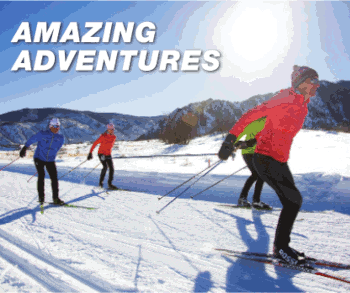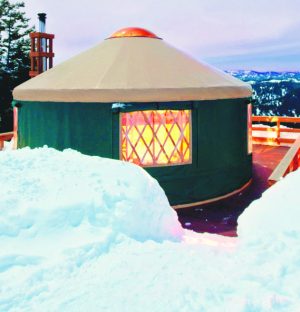April 20, 2008 (Callaghan Valley, B.C.) – Nearly 600 cross-country skiers converged at the 2010 Olympic venue in British Columbia’s Callaghan Valley for the 2008 Haywood Canadian XC Ski Nationals, March 16-23. It was the inaugural championships on the newly built Olympic courses, and one of the few big “trial runs†before the January 2009 XC World Cups. This being my first look at the trails, I was full of anticipation when I arrived in Canada.
The site of the 2010 Olympic Nordic events is nearly three hours north of Vancouver by car. Advertised as the host city of the winter Olympics, I was caught off guard by the green grass and drizzly warm weather that greeted us as we exited the Vancouver airport. I suspect that I was likely not the only skier bound for the XC Canadian Nationals to be surprised, as there was no indication of winter to be seen anywhere. What’s more, two hours later and roughly a hundred kilometers north of the Vancouver, there was still little reassurance that skiing was anywhere nearby. Aside from the distant snowy mountaintops, winter seemed to have given way to spring.
While snow was in short supply, that didn’t stop me from sitting back and enjoying the drive and the scenery, which proved to be quite spectacular. From the airport we made our way directly through the heart of what appeared to be a very ethnically diverse city, and then the metropolis of Vancouver gave way to a gorgeous fjord-like coastline. The road wove along steep rocky slopes overlooking an inlet dotted with lush, green islands.
The weather rolled in and out, as the mist gave way to periodic breaks of sunshine. On one side of the car water glistened on the coastline, and on the other, sheer rock faces jutted upward. Through further research I learned that the granite faces on the inland side apparently boast some of the best rocking climbing in all of Canada.
Coincidentally, the town of Squamish, which was our home base during the week of Canadian Nationals, is famous for attracting climbers from all over the world. Aside from the incredible rock formations, however, very little about this town would lead one to believe it’s a mecca for outdoor enthusiasts- climbers or skiers. It is true that we weren’t witnessing Squamish at the height of climbing season, but it also seemed an unsuspecting point of convergence for hundreds of cross-country ski racers.
The natural environment of the area and maritime weather patterns, as well as the surrounding community, was different from any other race destination I’d previously visited. What shocked me the most, however, was that there was little indication that Squamish was about to become a central part of the world’s largest winter sporting event. While the town is not hosting any of the Olympic events, it’s central location between Vancouver and Whistler literally puts it smack in the middle of the Olympics.
The cross-country venue is situated in a relatively remote area forty minutes north of the somewhat inconspicuous town of Squamish. For the week of the Canadian Nationals, some racers chose to lodge in Whistler (on the opposite side of the venue from Squamish), but with accommodations much more reasonably priced in Squamish, it was an easy financial call to avoid the resort town. While Whistler is known for being an alpine ski vacation destination and a winter wonderland, Squamish is in many ways its antithesis. It’s a somewhat rough working town, not a glitzy tourist stop, and the area feels more like a colder version of Seattle than a Winter Olympic paradise-to-be… while snow is falling in Whistler village, rain showers are watering the green lawns and emerging spring flowers in Squamish.
However, above the maritime weather of Squamish, in the forested mountains that jut upward, a very distinct snow line was present, hinting that winter (and skiing) was actually not far. A little higher up and less than fifty kilometers to the north is the truly spectacular Nordic venue where snow stays well into April. In the Callaghan Valley the snow pack is deep and the network of trails extends like a spider web through the surrounding wilderness. This pocket of winter is a skier’s dream, with trails varying in difficulty from challenging to “recreational†and covering a wide spectrum of terrain.
The Olympic courses are the most challenging, with substantial climbs and technical descents. There are two distinct classic and skate trails, each composed of 2.5km, 3.3km, 3.75km, and 5km loops from which to construct courses of differing lengths for both techniques. The skate course features abrupt hills, quick changes in pitch, and severe corners and is of a rolling nature. In contrast, the classic course is more smooth and gradual. The ascents are of a mellower grade, while appearing more sustained, and the curves are gentler. Both were the result of obvious planning and a good understanding of course construction.
These trails are just a small portion of this venue, however, as biathlon courses, and numerous recreational and moderate loops abound. On the first day of training, after skiing the race courses and coming to the quick conclusion that it was hard to keep my heart rate down, I discovered the easy and intermediate loops near the entrance – perfect L1 distance skiing. There, past the ski jump on “Cross Train,†“Lower Line Road,†and finally “Around the World,†I found myself completely alone on virgin corduroy. The following day in training I came upon more new trails. In an effort to avoid the chaos of the sprint competition, I purposely got lost on the vacant rolling biathlon trails to the north of the cross-country stadium.
With more trails yet to be discovered (as well as more that are yet to be built in the coming months), it is evident that British Columbia and the Callaghan Valley pleasantly surprised me. While their winter is hidden in a relatively remote, secluded area, it’s certainly there, and they’re making the most of it through the construction of some tremendous trails. This preview served as a first glance and has me excited to go back for more racing in the 2008-2009 season and beyond.
Top News Stories
2010 Olympic Preview of Callaghan Valley – First Impressions
Fabulous Site and Trails
by Tazlina MannixLeave a Reply
You must be logged in to post a comment.






![National camp action [P]...](https://skitrax.com/wp-content/uploads/2019/08/Duluth-4-2019-08-08-at-10.46.51-AM-300x246.png)
![Matt Liebsch on the CXC Elite Team [P] CXC...](https://skitrax.com/wp-content/uploads/2019/08/Matt-Liebsch-CXC.2-525x700.4-300x267.jpg)
![Dan LaBlanc [P]...](https://skitrax.com/wp-content/uploads/2019/08/Dan-LaBlanc-img_1855.3.jpg)

![Tazlina Mannix[P]Jeff Ellis file photo](http://skitrax.com/skitrax22/images/skitrax/480b4b4341ecfTaz.2.jpg)